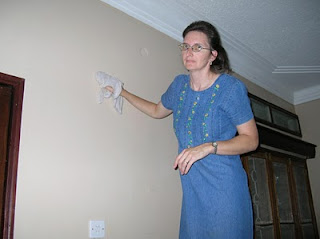SIZE 52?
One of the things that missionaries find themselves doing a couple of times a year is filling out questionnaires from supporting churches. These range in length from one page to four or more pages with varying questions. Last week I was filling one out that asked for the clothes sizes of our family. That one always throws me for a loop. By the time two or more boys have worn the shoes, the size has completely worn off. Or if I have purchased the shoes here, I never remember what the conversion is (my son wears a size 39?). I was checking the label of a pair of trousers, and it said 52. Hmmm...what size is that? I couldn't find a single American size in one of the boys' stack of trousers. (Trousers are worn on the outside. The term "pants" is used for the undergarment.) So how do I get clothes with such strange sizes?
My shopping for clothes involves several hours of searching and digging. In our area, we have two clothes' market days a week. Sellers buy bales of used clothes that have been shipped from Australia, England or America. Each bale is sorted by type: dresses, children trousers, men's shirts, etc. These clothes are then dumped out on tarps in the market area for anyone to dig through. And they love to help you look for things since they want you to buy from them. However, if you aren't accustomed to their ways, garments flung into your face at regular intervals may seem offensive. Being a frequent shopper, I am known by several of the vendors - especially those that sell trousers. A tape measure is a must for me as to bring white kids into a field of Ugandan vendors is quite the spectacle, and I get little looking done. So, my tape measure and a list of measurements are essential items to take along. As is the case with most purchasing here, the prices are negotiable. Being of a different color, we expect the prices to begin higher, but most usually will come to a reasonable price -- most of the time. A couple of weeks ago I came home very discouraged from shopping since my goal was to get shirts for Stanley, and I came home with just two. I had found three others, but the lady wanted three times the amount I had paid at another vendor (my white skin). Upon arriving home my first words to Keith were, "Please take me to an American thrift store where I know the price won't be according to my skin color."
My shopping for clothes involves several hours of searching and digging. In our area, we have two clothes' market days a week. Sellers buy bales of used clothes that have been shipped from Australia, England or America. Each bale is sorted by type: dresses, children trousers, men's shirts, etc. These clothes are then dumped out on tarps in the market area for anyone to dig through. And they love to help you look for things since they want you to buy from them. However, if you aren't accustomed to their ways, garments flung into your face at regular intervals may seem offensive. Being a frequent shopper, I am known by several of the vendors - especially those that sell trousers. A tape measure is a must for me as to bring white kids into a field of Ugandan vendors is quite the spectacle, and I get little looking done. So, my tape measure and a list of measurements are essential items to take along. As is the case with most purchasing here, the prices are negotiable. Being of a different color, we expect the prices to begin higher, but most usually will come to a reasonable price -- most of the time. A couple of weeks ago I came home very discouraged from shopping since my goal was to get shirts for Stanley, and I came home with just two. I had found three others, but the lady wanted three times the amount I had paid at another vendor (my white skin). Upon arriving home my first words to Keith were, "Please take me to an American thrift store where I know the price won't be according to my skin color."



Comments
Post a Comment